.: The Punctuated Tarot :.
"No man can lift up his tongue to read without punctuation." —Jewish saying
 |
The pilcrow or paragraph mark, ¶, signifies the beginning of a new theme.
Quite interestingly, the traditional Chinese paragraph sign is a thin circle—the same symbol as the character for “zero.” And so there’s actually an historical precedent for linking The Fool, the numeral zero, and the paragraph sign.
"And that blind paragraph mark with the curled tail!"
—Herbert Jones, Stanley Morison Displayed: An Examination of His Early Typographic Work
|
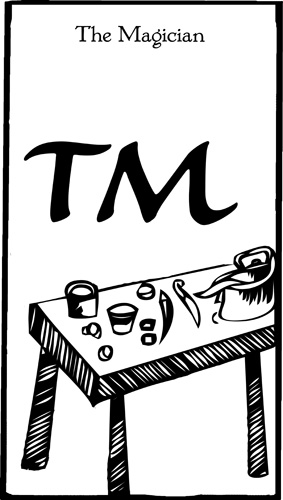 |
The trademark symbol, ™, suggests proprietorship.
"The magician's trademark 'top hat and tails' dates from Robert-Houdin."
—Michael Symes, Magic and Illusion
|
 |
The question mark, ?, represents uncertainty in the sense of mystique. It is a riddle as opposed to a quandary. The haziness of the veil doesn’t imply unclarity.
"Her marks on the pillars of wisdom are those of the question mark."
—Heather Busch & Burton Silver, Why Cats Paint (1994)
|
Tarot cards are like rebus puzzles, their pictures forming coded messages. “The practical language of Tarot is a language of question and answer. In that language, card meanings could be compared to the words, and spreads to the grammar” (Ruth Ann Amberstone & Wald Amberstone, Tarot Tips, 2003). Punctuation helps to bring clarity to the meaning of a sentence. Hence, the Punctuated Tarot: each card of the Major Arcana offers a different symbol for disambiguation.
Use the Punctuated Tarot cards by themselves or in combination with your favorite deck to reveal connections, distinctions, and places to breathe.
Just as traditional Tarot imagery distills the archetypes of our quest for wholeness, the standard marks and signs of punctuation clarify meaning as our story unfolds. “All our lives are punctuated, just as our books are punctuated with their commas, periods, semi-colons, exclamation points and other things, wondering how the next sentence will begin” (The Universalist Leader, Vol. 28, 1925).
Indeed, our lives are punctuated by transformational events, great and small:
- choices and consequences
- chance encounters
- joys and fears
- crises and crossings
- gains and losses
- absences, presences, and reconnections
- unexpected and unexplainable occurrences
- victories and disappointments
- psychological terrors and actual disasters
- deadlines and extensions
- remembrance and forgetting
- rituals and celebrations
- interpersonal conflicts
- gifts and sacrifices
- examinations
- stories
- windfalls
- shifts in attitudes
- physical challenges
- illnesses
- privileged moments
The Latin root of “punctuation” means to “point out” and to “bring to a point.” Punctuation marks help us to pinpoint the precise structure of the sentences that constitute our life story. Punctuation helps to organize and emphasize the themes at play. It assists us to comprehend the relationships that exist between nouns (the people, places, and things in our lives) and verbs (actions and occurrences). Punctuation can connect, isolate, confirm, limit, regulate, contrast, motivate and animate the flow of information—our intelligence. In other words, punctuation offers cues on how to understand the course of our experiences. Ultimately, punctuation is emphatic about pauses, whether brief or prolonged. Pauses invite us to linger on meaning, to reflect, to reevaluate. A pause gifts us with time to think twice. A pause offers a place to stand and to withstand.
Poet and veteran punctuation artist Gary Barwin considers punctuation marks to be “the secret operatives of language.” That’s because “punctuation makes no sound, but effects what is around it.” He evocatively calls punctuation “the hidden breathing” and “the ghosts in the machine.”
Barwin studies the pictographic nature of punctuation marks the way a paleographer might study petroglyphs. He explains: “I’m interested in the figure/ground relationship between punctuation and letters, but also the punctuation as pre-eminently non-vocal, iconic glyphs which are rich in association, graphic interest, and exist in the liminal space between writing and drawing, reading and looking at.” Anything liminal exudes a mystical aura, and Barwin naturally recognizes punctuation marks as magical symbols. He deems punctuation “a Kabbalah of the unspeakable, the pararational, the unknowlable. . . . And each mark has a certain conceptual and associational weight. They are like character actors in the drama of language. They are visual icons removed from sound or lexical meaning, but they shape semantics, grammar, breathing. They are physical yet not physical. Language from another textual world. If the letters are on one plane, punctuation appears in another, but from the surface of the page, they appear to be part of the same constellation.”
Barwin, too, relates punctuation marks to the Tarot: “We have a deep connection to these little dark marks. Each of them is like a tiny tarot-card, the reading of which depends on the reader. There are many ways to read their miniscule portraits.”
Praise for Divination by Punctuation
“Punctuation in tarot decks! There is much to say about it.”
—Quimby’s Bookstore (Chicago)
 |
The prime symbol of mathematics, ′, represents the “derivative function” (or, more generally, subsequence), just as a child descends from its mother. Note that the prime symbol can also represent feet (a short distance) and minutes (a short time).
"When empress, her prime duty had been to charm her subjects."
—Toby Faber, Fabergé's Eggs (2008)
|
 |
The ampersand, &, links the cards to its left and right, like a plus sign.
The ampersand is a symbol of organization. Like the Emperor, the sign brings people and things together.
"The sign & is said to be properly called Emperor’s hand, from having been first invented by some imperial personage, but by whom deponent saith not."
—William Shepard Walsh, Handy-book of Literary Curiosities (1892)
|
 |
The therefore sign, ∴, indicates a logical consequence.
If the Hierophant appears between two other cards, one might see the card on his right as the outcome of the card on his left.
"The hierophant is therefore an expounder."
—Kenneth Sylvan Guthrie, The Message of Philo Judaeus of Alexandria
|
 |
The section sign, §, refers to a distinct group within a larger body.
The formation of a unit presupposes a separation. In Venn diagram terms, even if a new unit remains within a larger circle, it is still delineated.
Intriguingly, the section symbol is composed of two overlapping capital S’s, much like the intertwining snakes of Hermes’ caduceus wand.
"I slipped over to the gardens and to the Lover's section."
—Once Upon A Time In Berbice
|
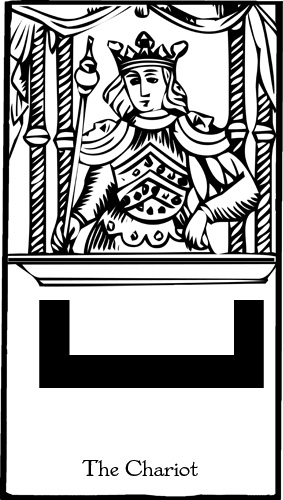 |
The space symbol, ␣, signifies the dimensions within which things move.
One might say that the chariot is inseparable from the road it traverses.
"The unprecedented run of that space 'chariot.'"
—Space World, 1971
|
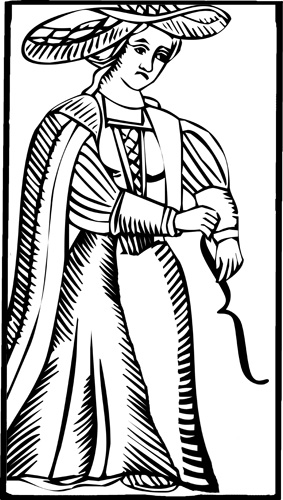 |
The brace, {, groups the cards to its right as a set.
Note that in the terminology of strength training, a set refers to the number of repeated movements within a given exercise. A set is always followed by a rest period.
"Strength braces every nerve."
—The Philosophical Magazine, 1809
|
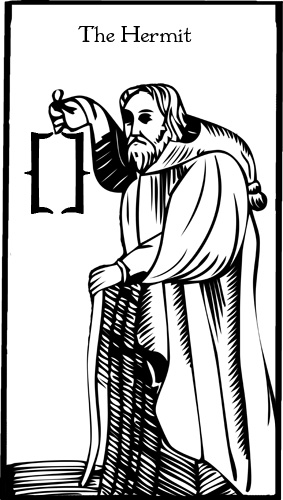 |
The square brackets, [ ], form a nest for missing material.
The square brackets have another use: it sometimes happens in writing that a parenthetical phrase occurs within another parenthetical phrase, and in such cases square brackets appear within the outer parentheses. Therefore, in a Tarot spread, square brackets can symbolize “deeper nesting.” Most commonly, square brackets enclose words added by someone besides the original author. And so they offer a sheltered realm for adding your own two cents when someone else is dictating.
"The Saints' days marked between brackets [ ], are not appointed by the Church."
—Charles Walker, A Prayer Book for the Young
|
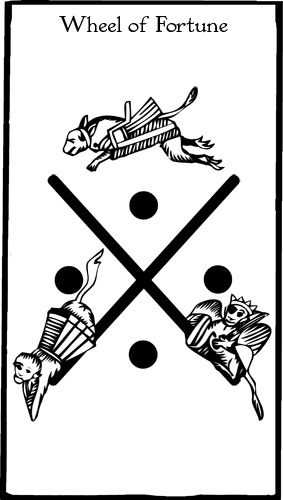 |
The reference mark, ※, suggests that supplementary information will be necessary for a full understanding.
In the language of tacheometry (surveying), a reference mark offers an easy way to check the alignment of one’s instruments if things are thrown off balance.
"A wheel of fortune (hereafter called the reference wheel)."
—Management Science, Vol. 24
|
 |
The percent sign, %, indicates a division.
It points to a tiny part, perhaps a dissenting group or minority opinion.
"It means we have justice for all, for everyone. That is 100 percent."
—Congressional Record, Nov. 12, 2002, p. 28768
|
 |
The semicolon, ;, signifies interdependency.
The reversed Hanged Man is typically associated with an inability to let go. The semicolon of course holds together two closely-related sentences. There’s tremendous tension in that act of fusing two units that can stand alone. The semicolon could be seen as a unifier and a peacemaker, but more and more writers consider the mark to be an unnecessary middleman. The fact that the semicolon is on the verge of becoming extinct in our language makes its Hanged Man appearance all the more poignant.
“[A] syntactical uneasiness, as if the semicolon hung precariously between two incompatible clauses that have been joined despite the lack of a logical connection between the ideas expressed in each one.”
—Deborah Houk Schocket, Modes of Seduction: Sexual Power in Balzac and Sand
|
 |
The ellipsis, ..., indicates an intentional omission or a trailing off.
Rather evocatively, the ellipsis has been called “the absent face” of a figure (Christian Metz & Michael Taylor, Film Language, 1991).
"Death is a textual ellipsis."
—Elisabeth Bronfen, Over Her Dead Body: Death, Femininity and the Aesthetic (1992)
|
 |
The tilde, ~, literally indicates a change in pronunciation and figuratively signifies a pronounced change.
In mathematics, the tilde can denote similarity, approximation, or equivalence.
The Tilde gives a letter a liquid sound.
—John Wilson, A Treatise on English Punctuation
|
 |
The numero sign, №, signifies numeration: a reckoning, a tallying.
Writ large, the numero sign looks like a “no” sign. “NO signs are everywhere. There’s no escaping them. They lurk at us from walls, windows, doors, buildings, fences, trucks, roads, and even trees. They are at train stations, bus depots, and airports. Wherever we travel, a NO sign lingers about—in cold bold, striking red, in scrawled letters or fancy script. They are ‘signs of the times,’ an anthropological-sociological measure of America; they are words penned by pundits, poets, philosophers, and would-be comics” (Mark Chester & George Toomer, No in America, 1986).
"He really got a kick out of the way that Numero phrased things. ... That sly devil sure is slick."
—Stephan R Hutchinson, A Trucker for President
|
 |
The exclamation point, !, signifies strong feelings or wonderment.
It is also a warning and hazard alert symbol.
"This will be the Signal tower, whose silhouette will be an impressive exclamation mark."
—Georges Binder, 101 of the World's Tallest Buildings
|
 |
The asterisk, *, indicates a digression.
The word “asterisk” comes from the Greek for “little star.” The asterisk typically points to an explanation. It is also used to stand in for something omitted.
The asterisk "originated as the sign that an enraged Hera placed on Zeus's brow when he slept where he shouldn't to remind him when he gazed into the mirror that he should be somewhere else."
—Sylvia Söderlind, Liminal Postmodernisms (1994)
|
 |
The degree symbol, °, signifies the extent to which something happens.
The degree symbol also commonly denotes temperature, as in the “Hotter/Colder” game of finding a hidden object.
Eye-in-the-wall don't look at me!
I wouldn't give you the Moon's degree.
—Delta: A Review of Arts, Life and Thought in the Netherlands
|
 |
The bullet, •, introduces items in a list.
The word “bullet” comes from the French for “small ball.” The small ball on this card suggests the Sol Niger, the paradoxical black sun that emits both light and darkness (for without light there can be no shadow). In alchemical terms, it is the blackening synonymous with melancholia. In Jungian terms, it is an archetype of the unconscious.
"She sees the sun like a bullet."
—Sue Walker, The Critical Response to Flannery O'Connor
|
 |
The interrobang, ‽, signifies a questionable surprise.
“As the first punctuation mark to enter the written code of the language in more than two centuries . . . the interrobang is also a symbol of the fact that man is more conservative with his writing than he is with his religion” (Lee C. Deighton, The Encyclopedia of Education, 1971).
"The rebirth of the long-forgotten interrobang."
—William Saffire, Quoth the Maven
|
 |
The copyright symbol, ©, concerns a creator's entitlements.
In proofreading, an encircled C signifies a self-correction.
"If the world does not want it, the copyright is of 'no account.'"
—The Publisher's Weekly, 1888
|
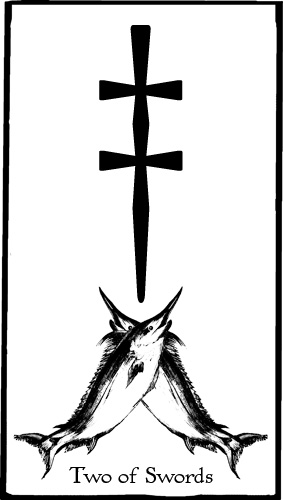 |
The double dagger, ‡, indicates a transition state in Chemistry.
"For like a double dagger, it may stab both ways."
—Boston Medical and Surgical Journal, 1913
|
An eccentric lexicographer and scholar, Craig Conley is author of the Tarot of Portmeirion, Magic Words: A Dictionary (Weiser Books) and One-Letter Words: A Dictionary (HarperCollins). His website is OneLetterWords.com.
~ ~ ~
|
























